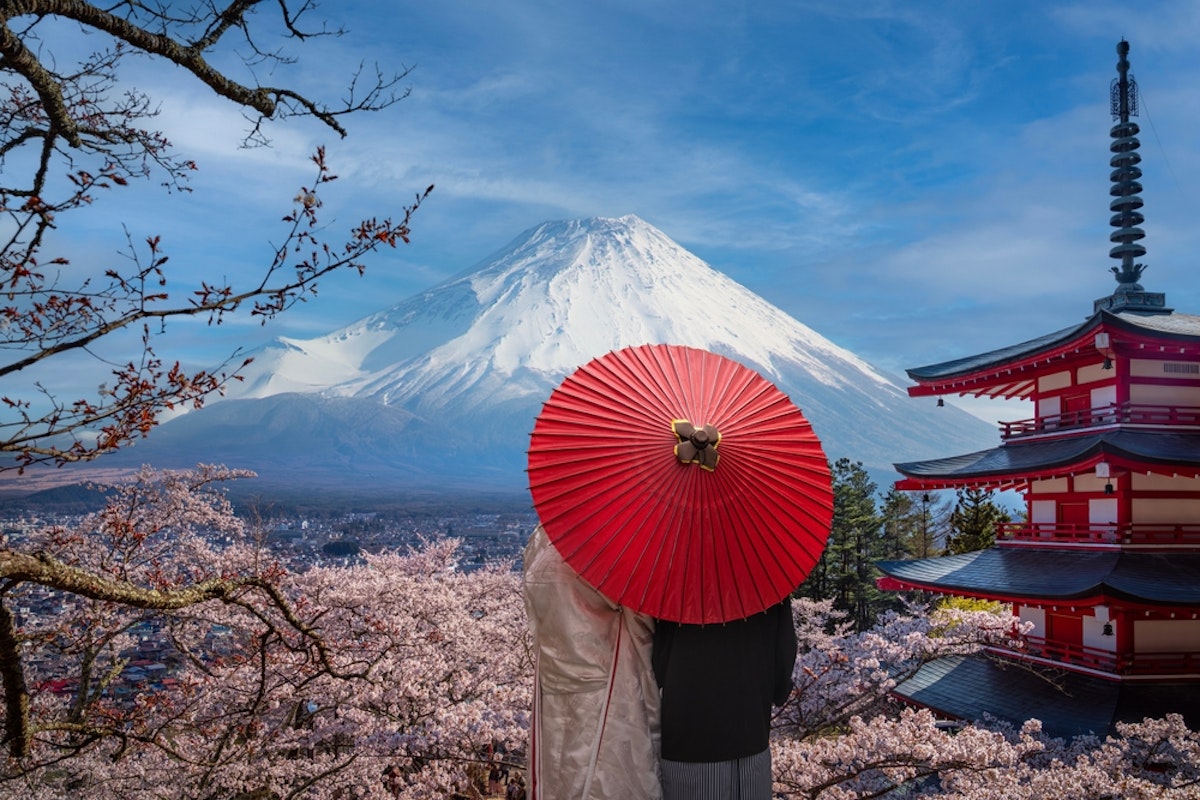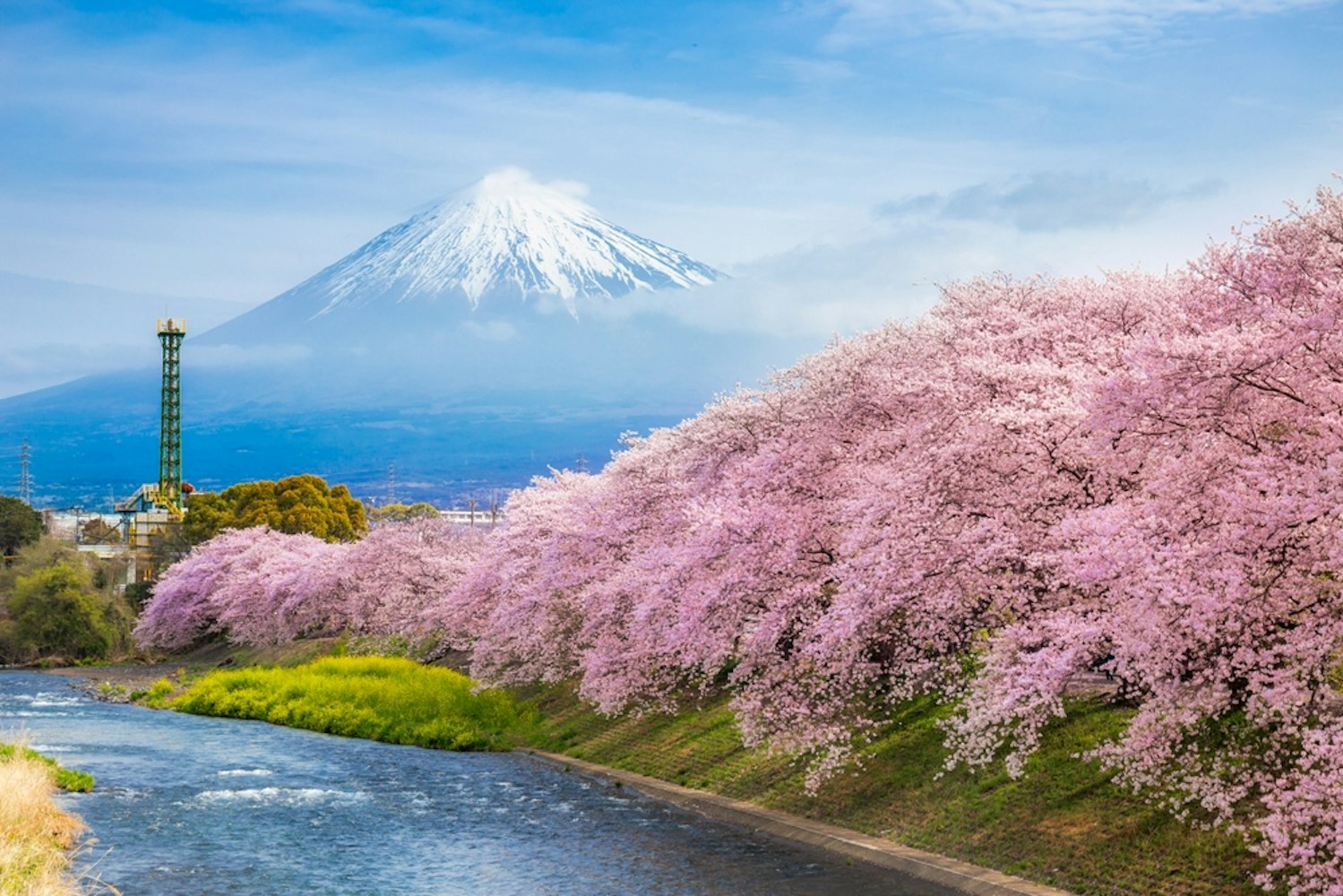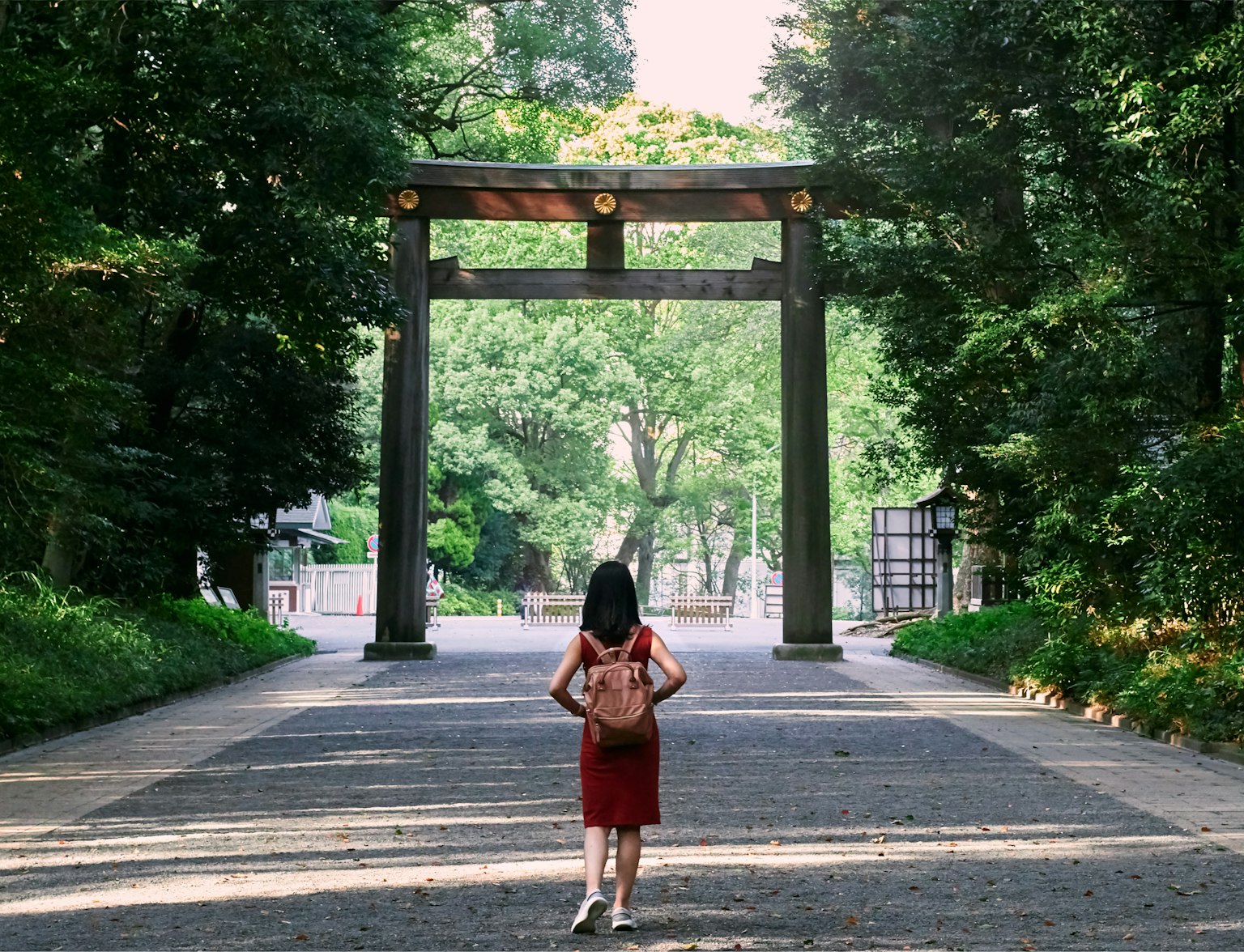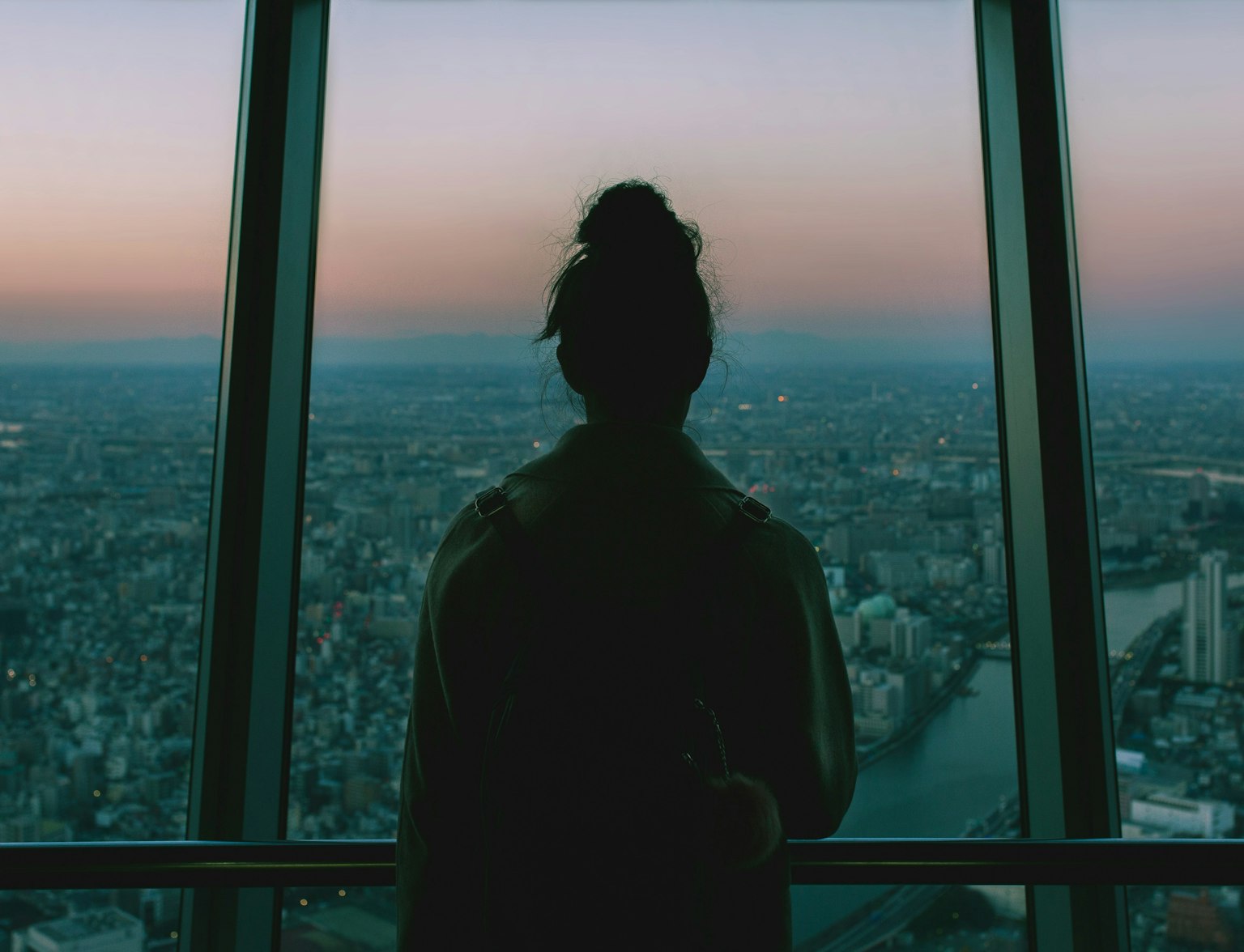

ภูเขาไฟฟูจิเป็นหนึ่งในสถานที่สําคัญที่เป็นที่รู้จักมากที่สุดของญี่ปุ่น เป็นยอดเขาธรรมชาติที่สวยงามซึ่งดึงดูดนักท่องเที่ยว ศิลปิน และคนในท้องถิ่นมานานหลายศตวรรษ ภูเขาสูงตระหง่านอยู่ที่ 3,776 เมตร (12,389 ฟุต) เป็นภูเขาที่สูงที่สุดในญี่ปุ่น และมักพบเห็นได้จากโตเกียวในวันที่อากาศแจ่มใส ไม่ว่าคุณจะมาเยือนโตเกียวสักสองสามวันหรืออยู่นานขึ้นการหาจุดชมวิวที่ดีเพื่อชมสัญลักษณ์อันน่าทึ่งของญี่ปุ่นแห่งนี้อาจเป็นประสบการณ์ที่คุ้มค่า
คู่มือนี้จะนําคุณไปสู่ สถานที่ที่ดีที่สุดในโตเกียว เพื่อชมภูเขาไฟฟูจิ เหตุใดสภาพอากาศและฤดูกาลจึงมีความสําคัญ และจุดใกล้เคียงที่คุณสามารถเพลิดเพลินกับทิวทัศน์ที่ใกล้ชิด

สัมผัสศิลปะ วัฒนธรรม และจิตวิญญาณรอบ ๆ ภูเขาไฟฟูจิในทัวร์ส่วนตัวแบบไปเช้าเย็นกลับ
แม้ว่า ภูเขาไฟฟูจิ อยู่ห่างจากโตเกียวไปทางตะวันตกเฉียงใต้เพียง 100 กิโลเมตร (62 ไมล์) การมองเห็นขึ้นอยู่กับสภาพของวัน สภาพอากาศ คุณภาพอากาศ และช่วงเวลาของปีล้วนมีบทบาทสําคัญ ภูเขาสามารถมองเห็นได้บ่อยกว่ามากในฤดูหนาวเมื่อเทียบกับฤดูร้อน เนื่องจากอากาศมีแนวโน้มที่จะปลอดโปร่งกว่ามาก ความชื้นและหมอกควันของโตเกียวในเดือนที่อากาศอบอุ่นสามารถบดบังทัศนียภาพได้ แม้ว่าท้องฟ้าจะดูเป็นสีฟ้าก็ตาม
ช่วงเวลาของวันก็มีความสําคัญเช่นกัน เช้าตรู่มักจะเป็นโอกาสที่ดีที่สุดในการชมภูเขาก่อนที่ความร้อนของวันจะทําให้เกิดหมอกควันในบรรยากาศ ช่วงบ่ายแก่ๆ หลังจากพายุฝนสามารถทําให้อากาศปลอดโปร่งได้
หากคุณต้องการชื่นชมภูเขาไฟฟูจิจากโตเกียว แต่ละจุดมีมุมมองที่เป็นเอกลักษณ์ของตัวเอง ดังนั้นการสํารวจบางจุดจึงคุ้มค่ากับความพยายาม

ตึกระฟ้าอันเป็นสัญลักษณ์ในชินจูกุแห่งนี้มีจุดชมวิวฟรี 2 แห่ง แห่งหนึ่งอยู่ที่หอคอยเหนือ และอีกแห่งหนึ่งอยู่ที่หอคอยใต้ ซึ่งตั้งอยู่บนชั้น 45
ทิวทัศน์จากหอคอยทางทิศใต้เหมาะอย่างยิ่งสําหรับการชมภูเขาไฟฟูจิ โดยเฉพาะอย่างยิ่งในวันที่มีหมอกควันต่ํา ทําเลใจกลางเมืองของอาคารทําให้เข้าถึงได้ง่าย และเข้าชมฟรีทําให้เป็นตัวเลือกที่น่าสนใจสําหรับนักเดินทาง
เวลาที่ดีที่สุด: เช้าตรู่ในช่วงฤดูหนาวเพื่อทัศนียภาพที่ชัดเจนที่สุด

ค้นพบเมืองโตเกียวที่มีชีวิตชีวาด้วยทัวร์ส่วนตัวของเรา
ในฐานะที่เป็นอาคารที่สูงที่สุดในญี่ปุ่น โตเกียวสกายทรีเป็นหนึ่งในจุดชมวิวที่สูงที่สุดในเมือง ดาดฟ้าสองชั้น - ชั้นหนึ่งอยู่ที่ 350 เมตรและอีกชั้นหนึ่งที่ความสูง 450 เมตรเหนือพื้นดิน - ให้ทัศนียภาพแบบพาโนรามาที่ทอดยาวไปจนถึงภูเขาไฟฟูจิในวันที่อากาศแจ่มใส ดาดฟ้าที่สูงขึ้นที่เรียกว่า Tembo Galleria เป็นตัวเลือกที่ดีกว่าสําหรับการชมภูเขา

ปลดล็อกวันแห่งความมหัศจรรย์ในโตเกียว!
อาคาร 54 ชั้นในรปปงหงิแห่งนี้เป็นสถานที่ที่ยอดเยี่ยมอีกแห่งหนึ่งในการชมทิวทัศน์ของภูเขาไฟฟูจิ จุดชมวิวโตเกียวซิตี้วิวซึ่งตั้งอยู่ในอาคารมีทิวทัศน์ของเมืองที่กว้างไกล แต่หากต้องการชมฟูจิที่ดีที่สุด ให้ไปที่ Sky Deck
พื้นที่บนชั้นดาดฟ้าแบบเปิดโล่งนี้ช่วยให้มองเห็นทิวทัศน์ของภูเขาโดยไม่มีสิ่งกีดขวาง โดยเฉพาะอย่างยิ่งในช่วงพระอาทิตย์ตกดินเมื่อแสงสีทองช่วยเพิ่มความสวยงาม

ดําดิ่งสู่ทัศนียภาพอันงดงามจากหอคอย Roppongi Hills Mori
หากคุณชอบธรรมชาติ ภูเขาทาคาโอะซึ่งตั้งอยู่นอกใจกลางกรุงโตเกียวเป็นจุดที่ยอดเยี่ยม การเดินป่าระยะสั้นไปยังยอดเขาจะทําให้คุณได้สัมผัสกับบรรยากาศที่เงียบสงบเพื่อเพลิดเพลินกับภูเขาไฟฟูจิ
ในวันที่อากาศแจ่มใสเป็นพิเศษ ทิวทัศน์จะสวยงาม ด้วยภูเขาที่ล้อมรอบด้วยต้นไม้เขียวขจี การมาเยือนในช่วงฤดูใบไม้ร่วงหรือฤดูดอกซากุระจะช่วยเพิ่มสัมผัสพิเศษให้กับประสบการณ์

สัมผัสสถานที่สําคัญที่เป็นสัญลักษณ์ของโตเกียวด้วยทัวร์รถยนต์ส่วนตัวเต็มวันที่ปรับแต่งได้
สนามบินฮาเนดะไม่ได้มีไว้สําหรับการขึ้นเครื่องบินเท่านั้น แต่ยังเป็นจุดที่น่าประหลาดใจสําหรับทิวทัศน์ภูเขาไฟฟูจิอีกด้วย ทั้งอาคารผู้โดยสารภายในประเทศและระหว่างประเทศมีจุดชมวิวที่เปิดให้ประชาชนทั่วไปเข้าชม ซึ่งคุณสามารถผ่อนคลายและมองเห็นบริเวณอ่าวโตเกียวที่มีภูเขาไฟฟูจิอยู่เบื้องหลัง

สัมผัสประสบการณ์บริการรับส่งส่วนตัวที่ไม่ยุ่งยากด้วยรถตู้สุดหรูจากโตเกียวไปยังสนามบินฮาเนดะ
สําหรับผู้ที่ชื่นชอบทิวทัศน์ริมน้ํา Odaiba Seaside Park มีสภาพแวดล้อมที่ผ่อนคลายพร้อมทิวทัศน์ที่สวยงามของภูเขาไฟฟูจิ การเยี่ยมชมในช่วงพระอาทิตย์ตกดินจะให้ทัศนียภาพอันเงียบสงบของภูเขาที่สะท้อนอยู่ในน้ํา
คุณยังสามารถรวมการเยี่ยมชมของคุณกับการสํารวจสถานที่ท่องเที่ยวอื่นๆ ของโอไดบะ เช่น สะพานสายรุ้งหรือพิพิธภัณฑ์ศิลปะดิจิทัล teamLab Borderless

ค้นพบอัญมณีที่ซ่อนอยู่ของโตเกียวบนเรือสําราญอาซากุสะไปยังโอไดบะของเรา!
จุดที่ไม่ค่อยมีใครรู้จักแห่งนี้เป็นที่ชื่นชอบของผู้ที่มองหาประสบการณ์การรับชมที่เงียบสงบและฟรี เลานจ์ชมวิวบนชั้น 25 ให้ทัศนียภาพอันงดงามของทิวทัศน์ของเมือง และในวันที่อากาศแจ่มใส จะมองเห็นภูเขาไฟฟูจิได้ในระยะไกล มีผู้คนพลุกพล่านน้อยกว่าสถานที่ยอดนิยมบางแห่ง จึงเป็นตัวเลือกที่ดีหากคุณต้องการบรรยากาศที่ผ่อนคลายมากขึ้น

ค้นพบเสน่ห์อันน่าหลงใหลของโตเกียวในทัวร์เดินเท้าส่วนตัว
ริมฝั่งแม่น้ําทามะ โดยเฉพาะอย่างยิ่งใกล้กับ Futako-Tamagawa เป็นสถานที่ที่เงียบสงบในการชมภูเขาไฟฟูจิที่ล้อมรอบด้วยท้องฟ้าเปิดโล่งและภูมิทัศน์ของเมือง การเดินเล่นหรือขี่จักรยานไปตามแม่น้ําจะทําให้การออกนอกบ้านน่ารื่นรมย์ในขณะที่คุณรอชมทิวทัศน์ที่สมบูรณ์แบบ

ปลดปล่อยจิตวิญญาณแห่งการผจญภัยของคุณด้วยทัวร์ล่องแก่งแม่น้ําทามะในโอเมะ โตเกียว
ตรวจสภาพอากาศ: ใช้แอพพยากรณ์อากาศหรือเว็บไซต์เพื่อติดตามการพยากรณ์ทัศนวิสัยของภูเขาไฟฟูจิ วันฤดูหนาวโดยเฉพาะหลังฝนตกมักจะมีสภาพที่ดีที่สุด
ช่วงเวลาของวัน: เช้าตรู่โดยทั่วไปเป็นช่วงเวลาที่ดีที่สุดสําหรับท้องฟ้าแจ่มใส
อุปกรณ์สําหรับถ่ายภาพ: หากคุณชอบถ่ายภาพ ให้นําเลนส์ซูมมาเพื่อถ่ายภาพภูเขาที่มีรายละเอียดจากระยะไกล
หากการชมภูเขาไฟฟูจิจากระยะไกลไม่เพียงพอ ให้ลองไปเที่ยวแบบไปเช้าเย็นกลับเพื่อเข้าใกล้มากขึ้น จุดเหล่านี้เป็นจุดหมายปลายทางยอดนิยมสําหรับการเพลิดเพลินกับภูเขาอย่างใกล้ชิด:
ทะเลสาบคาวากุจิอาจเป็นจุดที่มีชื่อเสียงที่สุดในการชมภูเขาไฟฟูจิอย่างใกล้ชิด ทะเลสาบสะท้อนภูเขาบนผิวน้ํา ทําให้เกิดเอฟเฟกต์เหมือนกระจกที่โดดเด่นเป็นพิเศษในภาพถ่าย พื้นที่นี้มีอุปกรณ์ครบครันสําหรับผู้มาเยือน โดยมีร้านกาแฟ บ่อน้ําพุร้อน และจุดถ่ายรูปมากมาย

เริ่มต้นการเดินทางอันน่าทึ่งไปยังภูเขาไฟฟูจิและทะเลสาบคาวากุจิ
ฮาโกเน่ขึ้นชื่อเรื่องน้ําพุร้อนและทิวทัศน์อันงดงาม เป็นการผสมผสานระหว่างการผ่อนคลายและทิวทัศน์อันน่าทึ่ง พื้นที่ กระเช้าลอยฟ้าฮาโกเน่ และทะเลสาบอาชิเป็นที่รู้จักกันดีเป็นพิเศษในด้านทัศนียภาพอันงดงามของภูเขาไฟฟูจิ หลายคนรวมการมาเยือนกับการเข้าพักในเรียวกังแบบดั้งเดิมเพื่อเพลิดเพลินกับภูมิภาคนี้อย่างเต็มที่

สํารวจภูมิทัศน์อันน่าทึ่งของภูเขาไฟฟูจิและฮาโกเน่ในทัวร์ส่วนตัว
จุดนี้ในสวนอาราคุรายามะเซ็นเก็นเป็นความฝันของช่างภาพ เจดีย์ห้าชั้นที่มีฉากหลังเป็นภูเขาไฟฟูจิเป็นฉากที่กลายเป็นสัญลักษณ์ไปทั่วโลก ดอกซากุระในฤดูใบไม้ผลิหรือใบไม้ที่สดใสในฤดูใบไม้ร่วงช่วยเพิ่มความสวยงามให้กับบรรยากาศ

ค้นพบภูมิทัศน์อันน่าทึ่งของญี่ปุ่นด้วยไกด์นําเที่ยวเต็มวัน
ช่วงเวลาของปีมีบทบาทสําคัญในการมองเห็นภูเขาไฟฟูจิจากโตเกียวบ่อยแค่ไหน นี่คือสิ่งที่คาดหวัง:
ฤดูหนาว (ธันวาคม-กุมภาพันธ์): ท้องฟ้าแจ่มใสที่สุดและมีโอกาสได้เห็นภูเขาไฟฟูจิมากที่สุด ยอดเขาที่ปกคลุมด้วยหิมะช่วยเพิ่มเสน่ห์เป็นพิเศษ
ฤดูใบไม้ผลิ (มีนาคม-พฤษภาคม): ในขณะที่ดอกซากุระบาน ทัศนวิสัยอาจแตกต่างกันไป ตอนเช้าที่เย็นกว่ามักจะให้โอกาสที่ดีกว่า
ฤดูร้อน (มิถุนายน–สิงหาคม): ความชื้นสูงและเมฆฝนบ่อยมักบดบังภูเขา นี่คือฤดูกาลปีนเขาสําหรับผู้ที่วางแผนจะปีนขึ้นไปบนยอดเขา
ฤดูใบไม้ร่วง (กันยายน-พฤศจิกายน): อากาศที่เย็นลงและความชื้นที่ลดลงช่วยเพิ่มทัศนวิสัย โดยเฉพาะอย่างยิ่งในเดือนต่อๆ ไป
นอกเหนือจากความงามตามธรรมชาติแล้ว ภูเขาไฟฟูจิยังมีความสําคัญทางวัฒนธรรม จิตวิญญาณ และประวัติศาสตร์ในญี่ปุ่นอีกด้วย เป็นสถานที่ศักดิ์สิทธิ์มานานหลายศตวรรษ มักเกี่ยวข้องกับการปฏิบัติของศาสนาชินโตและพุทธศาสนา ศิลปินอย่างโฮคุไซและฮิโรชิเงะทําให้รูปแบบของมันเป็นอมตะในภาพพิมพ์แกะไม้อุคิโยะเอะ ซึ่งยังคงเป็นผลงานศิลปะญี่ปุ่นที่โด่งดังที่สุด
ปีน เขา ภูเขาไฟฟูจิ ถือเป็นการเดินทางทางจิตวิญญาณสําหรับหลาย ๆ คน เป็นสัญลักษณ์ของความอุตสาหะและการเชื่อมต่อกับธรรมชาติ แม้ว่าคุณจะแค่ชื่นชมจากระยะไกล แต่การปรากฏตัวของภูเขาก็ทําให้เกิดความรู้สึกเงียบสงบและความเกรงขาม
คุณสามารถเห็นภูเขาไฟฟูจิจากโตเกียวทุกวันได้หรือไม่?
ทัศนวิสัยขึ้นอยู่กับสภาพอากาศและคุณภาพอากาศ วันที่อากาศแจ่มใส โดยเฉพาะในช่วงฤดูหนาว เป็นโอกาสที่ดีที่สุดในการชมภูเขาไฟฟูจิจากโตเกียว วันฤดูร้อนมักจะมีหมอกควัน ทําให้มองเห็นภูเขาได้ยากขึ้น
ช่วงเวลาที่ดีที่สุดในการชมภูเขาไฟฟูจิจากโตเกียวคืออะไร?
ฤดูหนาว (ธันวาคมถึงกุมภาพันธ์) ให้มุมมองที่ชัดเจนที่สุดเนื่องจากความชื้นต่ําและหมอกควันน้อยลง เช้าตรู่และบ่ายแก่ๆ หลังจากพายุฝนยังช่วยเพิ่มทัศนวิสัย
หอสังเกตการณ์ใดในโตเกียวที่เหมาะสําหรับการชมภูเขาไฟฟูจิ?
จุดชมวิวยอดนิยม ได้แก่ อาคารรัฐบาลกรุงโตเกียว โตเกียวสกายทรี และรปปงงิฮิลล์โมริทาวเวอร์ แต่ละแห่งมีมุมมองที่ไม่เหมือนใครและทิวทัศน์ที่ชัดเจนของภูเขาในวันที่อากาศดี
ฉันสามารถมองเห็นภูเขาไฟฟูจิจากโตเกียวในตอนกลางคืนได้หรือไม่?
โดยทั่วไปแล้วภูเขาไฟฟูจิจะมองไม่เห็นในเวลากลางคืนเนื่องจากไม่มีแสงสว่าง อย่างไรก็ตาม บางครั้งสามารถมองเห็นเงาของภูเขาได้ในช่วงคืนพระจันทร์เต็มดวงหรือเมื่อหิมะปกคลุมยอดเขาและสะท้อนแสง
ภูเขาไฟฟูจิมองเห็นได้จากสนามบินในโตเกียวหรือไม่?
ใช่ จุดชมวิวของสนามบินฮาเนดะมีทิวทัศน์อันงดงามของภูเขาไฟฟูจิในวันที่อากาศแจ่มใส สนามบินนาริตะอยู่ไกลกว่าและไม่เหมาะสําหรับการชมภูเขา



